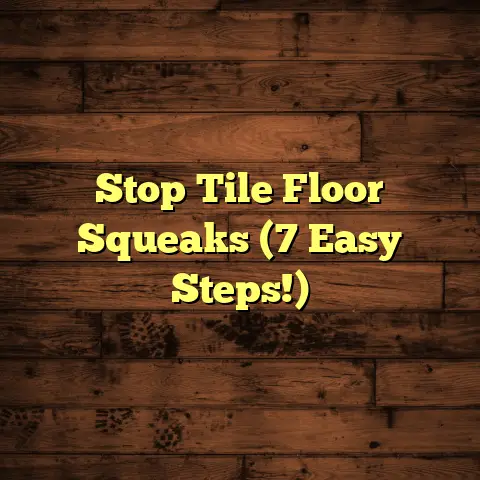Heat Concrete Floors? (3 Costly Errors!)
Concrete’s been making a huge splash lately, and for good reason.
It’s modern, durable, and can be seriously comfy underfoot, especially when you add radiant heat.
But here’s the thing: heated concrete floors aren’t a walk in the park.
I’ve witnessed firsthand how easily things can go south, leading to major headaches and emptying wallets.
That’s why I’m spilling the beans on the three most common, and costly, errors I see people make.
Trust me, avoiding these mistakes can save you a ton of money and keep your toes toasty for years to come.
The Allure of Heated Concrete Floors
Let’s be honest, who doesn’t want a warm floor on a chilly morning?
Heated concrete floors are more than just a luxury; they’re a smart investment.
They offer a unique blend of energy efficiency, consistent comfort, and design freedom.
Think about it: no more cold tile shock in the bathroom!
Radiant floor heating, the tech behind this magic, works by warming the floor itself, which then radiates heat upwards, creating a consistent and comfortable temperature throughout the room.
This is way more efficient than traditional forced-air systems, which often leave you with hot and cold spots.
According to the Radiant Professionals Alliance (RPA), radiant floor heating can save you up to 30% on your energy bills compared to traditional heating methods.
Plus, concrete is incredibly versatile.
You can stain it, polish it, or even stamp it to create a look that perfectly matches your style.
I’ve seen everything from sleek, modern gray concrete floors to rustic, earthy tones that add warmth and character to a space.
It’s no wonder the demand for heated concrete flooring is on the rise.
Builders and homeowners alike are recognizing the benefits, and I’m here to help you do it right.
Costly Error #1: Inadequate Planning and Design
Alright, let’s dive into the first major pitfall: inadequate planning and design.
This is where a lot of projects go off the rails, and it’s often the most preventable.
Think of it like building a house – you wouldn’t start without a blueprint, right?
The same goes for heated concrete floors.
One of the biggest mistakes I see is failing to properly assess the thermal dynamics of the space.
What does that mean?
Well, you need to consider things like:
Insulation: How well insulated are your walls and windows?
Poor insulation means heat loss, and that means your system will have to work harder (and cost you more) to maintain a comfortable temperature.-
Room Size and Layout: A large, open-concept space will require a different heating strategy than a small, enclosed room.
Climate: Are you in a cold climate with long winters?
Or a milder climate with shorter heating seasons?
This will affect the size and type of system you need.
Another common oversight is neglecting to consider the layout of furniture and fixtures.
Large rugs or furniture placed directly on top of the heated floor can block the heat and create hot spots.
I once worked on a project where the homeowner had placed a massive area rug over a large portion of their heated concrete floor.
The result?
The system struggled to heat the rest of the room, and the area under the rug became uncomfortably hot.
We ended up having to relocate the rug and adjust the system to compensate, which cost the homeowner extra money and time.
Real-Life Example:
I consulted on a project where the homeowner, eager to save money, decided to skip the professional design phase.
They installed a heated concrete floor in their sunroom without properly insulating the walls and windows.
The result was a system that struggled to keep the room warm in the winter, and their energy bills skyrocketed.
They ended up spending more money in the long run to retrofit insulation and upgrade the heating system.
The Lesson?
Don’t skimp on the planning and design phase.
It’s an investment that will pay off in the long run.
Consult with a qualified professional who can assess your space, recommend the right system, and create a detailed plan that takes into account all of these factors.
Costly Error #2: Poor Installation Practices
Okay, you’ve got a solid plan in place. Great!
But the job’s not done yet.
Proper installation is absolutely crucial for the success of your heated concrete floor.
This is where hiring a qualified and experienced installer is worth its weight in gold.
I can’t stress this enough: DIY is not the way to go here unless you’re a seasoned pro.
I’ve seen so many homeowners try to save a few bucks by doing the installation themselves, only to end up with a system that doesn’t work properly, or worse, is downright dangerous.
One of the most common installation errors I see is improper wiring or tubing placement.
The heating elements (either electric wires or hydronic tubing) need to be spaced correctly and embedded at the right depth in the concrete slab.
If they’re too close to the surface, they can cause hot spots and cracking.
If they’re too deep, the system will be inefficient and take longer to heat up.
Another critical aspect is using the correct concrete mix.
The concrete needs to be specifically formulated for radiant floor heating systems.
It should have good thermal conductivity to efficiently transfer heat, and it should be durable enough to withstand the stresses of expansion and contraction.
I once had to tear out an entire heated concrete floor because the installer used the wrong type of concrete.
It cracked and crumbled within a few years, rendering the system useless.
And of course, it’s essential to follow the manufacturer’s guidelines to the letter.
Each system has its own specific installation requirements, and deviating from those instructions can lead to serious problems.
Anecdote:
I remember a homeowner who hired a “bargain” installer to put in their heated floor.
The installer rushed the job, didn’t follow the manufacturer’s instructions, and used substandard materials.
Within a year, the system started to malfunction, and the floor began to crack.
The homeowner ended up having to spend thousands of dollars to repair the damage and replace the faulty components.
The Takeaway?
Don’t cut corners on installation.
Hire a qualified and experienced installer who knows what they’re doing.
Check their credentials, ask for references, and make sure they’re familiar with the specific type of system you’re installing.
It’s an investment that will pay off in the long run by ensuring your system works efficiently, reliably, and safely.
Costly Error #3: Neglecting Maintenance and Monitoring
So, you’ve planned your system meticulously and hired a top-notch installer.
Congratulations! But don’t get complacent just yet.
Regular maintenance and monitoring are essential for the longevity and efficiency of your heated concrete floor.
Think of it like your car – you wouldn’t drive it for years without changing the oil or checking the tires, would you?
The same principle applies to your heated floor.
One of the most common pitfalls I see is simply ignoring the system after it’s installed.
Homeowners often assume that once it’s up and running, it’ll take care of itself.
But that’s not the case.
You need to keep an eye on things like temperature fluctuations.
Are certain areas of the floor consistently warmer or cooler than others?
This could indicate a problem with the system, such as a leak or a faulty heating element.
Speaking of leaks, it’s crucial to check for them regularly, especially if you have a hydronic system.
Even a small leak can cause significant damage to your floor and subfloor over time.
I recommend having your system professionally inspected at least once a year to catch any potential problems early.
Another often-overlooked aspect of maintenance is keeping the system clean.
Dust, dirt, and debris can accumulate on the floor and reduce its thermal efficiency.
Regularly sweeping or vacuuming the floor can help keep it clean and ensure that the heat is radiating properly.
Professional Insight:
I spoke with a colleague, a seasoned HVAC technician, about the long-term consequences of neglect.
He told me that he’s seen countless cases of heated floor systems failing prematurely due to lack of maintenance.
“People think these systems are bulletproof,” he said, “but they’re not.
They need regular checkups and maintenance just like any other mechanical system.”
He emphasized that neglecting maintenance can lead to costly repairs and replacements down the road.
The Bottom Line?
Don’t neglect maintenance and monitoring.
Set up a regular schedule for inspections and cleaning, and pay attention to any unusual signs or symptoms.
By taking a proactive approach, you can prevent small problems from turning into big, expensive ones.
The Financial Impact of These Errors
Alright, let’s talk numbers.
What’s the real cost of these mistakes?
The financial ramifications of inadequate planning, poor installation, and neglecting maintenance can be significant.
Let’s break it down:
Inadequate Planning: As I mentioned earlier, skipping the professional design phase can lead to inefficient heating, higher energy bills, and the need for costly retrofits.
I estimate that inadequate planning can easily add 10-20% to the overall cost of the project in the long run.Poor Installation: This is where things can get really expensive.
A faulty installation can lead to system malfunctions, cracked floors, and even water damage.
Repairing or replacing a poorly installed heated floor can cost thousands of dollars, often exceeding the initial cost of the installation itself.
I’ve seen homeowners spend upwards of $10,000 to fix botched installations.Neglecting Maintenance: Ignoring maintenance can lead to gradual system degradation, reduced efficiency, and premature failure.
Replacing a failed heated floor system can be a major expense, often costing several thousand dollars or more.
Regular maintenance, on the other hand, can help extend the life of your system and prevent costly breakdowns.
Comparison:
Let’s say you’re installing a heated concrete floor in a 500-square-foot room.
A proper installation, including professional design, quality materials, and experienced labor, might cost you around $7,500.
Now, let’s say you try to cut corners and end up with a poorly installed system that fails within a few years.
Replacing that system could easily cost you $10,000 or more, plus the added inconvenience and disruption.
The Smart Choice?
Invest in quality from the start.
Spend the extra money on professional design, experienced installation, and regular maintenance.
It’s a small price to pay for the peace of mind knowing that your heated concrete floor is working efficiently, reliably, and safely for years to come.
Conclusion
So, there you have it: the three most costly errors to avoid when heating concrete floors.
While heated concrete floors offer a ton of benefits, including energy efficiency, comfort, and design versatility, they’re not without their challenges.
Improper planning, poor installation, and neglecting maintenance can all lead to significant financial losses and a whole lot of headaches.
But don’t let that scare you away!
By approaching your heated flooring project with care and diligence, you can avoid these pitfalls and enjoy the many benefits of a warm, comfortable, and energy-efficient home.
Remember to consult with qualified professionals, invest in quality materials and installation, and maintain your system regularly.
The comfort and efficiency of your home or business are well worth the effort to get it right.
And hey, if you ever need a hand, you know where to find me!





